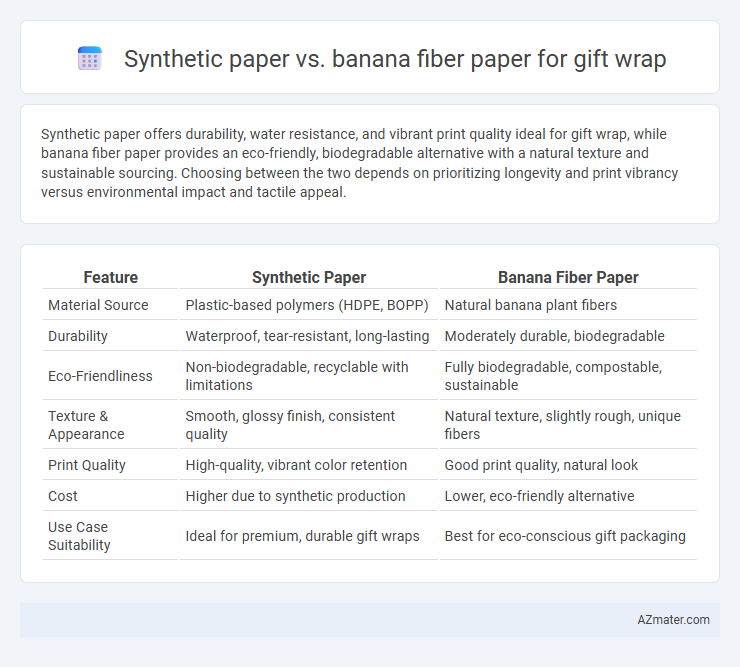Synthetic paper offers durability, water resistance, and vibrant print quality ideal for gift wrap, while banana fiber paper provides an eco-friendly, biodegradable alternative with a natural texture and sustainable sourcing. Choosing between the two depends on prioritizing longevity and print vibrancy versus environmental impact and tactile appeal.
Table of Comparison
| Feature | Synthetic Paper | Banana Fiber Paper |
|---|---|---|
| Material Source | Plastic-based polymers (HDPE, BOPP) | Natural banana plant fibers |
| Durability | Waterproof, tear-resistant, long-lasting | Moderately durable, biodegradable |
| Eco-Friendliness | Non-biodegradable, recyclable with limitations | Fully biodegradable, compostable, sustainable |
| Texture & Appearance | Smooth, glossy finish, consistent quality | Natural texture, slightly rough, unique fibers |
| Print Quality | High-quality, vibrant color retention | Good print quality, natural look |
| Cost | Higher due to synthetic production | Lower, eco-friendly alternative |
| Use Case Suitability | Ideal for premium, durable gift wraps | Best for eco-conscious gift packaging |
Introduction to Gift Wrap Materials
Synthetic paper offers durability, water resistance, and smooth texture, making it an ideal choice for gift wrap that requires longevity and vibrant print quality. Banana fiber paper, derived from natural banana plant fibers, emphasizes eco-friendliness, biodegradability, and a unique textured appearance appealing to sustainable packaging. Both materials cater to different consumer preferences, balancing between synthetic resilience and natural aesthetics in gift wrap applications.
What is Synthetic Paper?
Synthetic paper is a durable, water-resistant material made from plastic resins like polypropylene or polyethylene, offering tear-resistant and smooth printing surfaces ideal for gift wrap. Unlike banana fiber paper, which is biodegradable and derived from natural banana plant fibers, synthetic paper provides long-lasting, vibrant prints that withstand moisture and handling. Its versatility and resistance to environmental factors make it a practical choice for reusable or premium gift-wrapping solutions.
Understanding Banana Fiber Paper
Banana fiber paper, derived from the bark of banana plants, offers eco-friendly gift wrap with natural texture and durability, making it biodegradable and compostable compared to synthetic paper made from plastic polymers. Its sustainable production process reduces environmental impact by utilizing agricultural waste, enhancing its appeal for eco-conscious consumers seeking biodegradable alternatives. The fibers provide a unique aesthetic with natural variations, promoting a rustic, organic look that synthetic paper cannot replicate without harmful additives.
Environmental Impact: Synthetic vs Banana Fiber Paper
Synthetic paper, made from plastic resins such as polypropylene, poses significant environmental challenges due to its non-biodegradable nature and reliance on fossil fuels, leading to persistent microplastic pollution and high carbon emissions during production. Banana fiber paper, derived from agricultural byproducts, offers a sustainable alternative with its biodegradable properties, low energy consumption, and contribution to waste reduction by utilizing otherwise discarded banana plant material. Choosing banana fiber paper for gift wrap promotes eco-friendly practices by minimizing landfill waste and reducing the environmental footprint compared to synthetic counterparts.
Durability and Strength Comparison
Synthetic paper offers superior durability and tear resistance compared to banana fiber paper, making it ideal for gift wrap that requires longer-lasting protection and multiple uses. Banana fiber paper, while eco-friendly and biodegradable, generally has lower tensile strength and is more prone to tearing under stress. When choosing a gift wrap, synthetic paper ensures enhanced strength and moisture resistance, whereas banana fiber paper is better suited for short-term, sustainable packaging needs.
Print Quality and Design Versatility
Synthetic paper offers superior print quality with sharp, vibrant colors and smooth surfaces ideal for detailed graphics, enhancing the visual appeal of gift wrap designs. Banana fiber paper provides a natural texture and eco-friendly appeal but may result in slightly muted prints and less design precision due to its fibrous composition. Design versatility is higher with synthetic paper as it supports diverse printing techniques and finishes, whereas banana fiber paper suits rustic, organic aesthetics favored in sustainable packaging.
Cost Effectiveness for Gift Wrapping
Synthetic paper offers superior durability and water resistance but tends to be higher in cost compared to banana fiber paper, which is more affordable and eco-friendly due to its biodegradable nature. Banana fiber paper provides a unique texture and natural aesthetic, enhancing the gift wrap's visual appeal while remaining budget-friendly, making it a favorable option for cost-effective sustainable wrapping. For large-scale gift wrapping, selecting banana fiber paper can reduce expenses significantly without compromising on quality or environmental impact.
Biodegradability and Recycling Options
Synthetic paper offers durability and water resistance but poses significant challenges in biodegradability, often persisting in the environment due to its plastic-based components. Banana fiber paper, derived from natural banana plant waste, excels in biodegradability and compostability, breaking down quickly without leaving harmful residues. Recycling options for synthetic paper are limited and require specialized facilities, while banana fiber paper easily integrates into standard paper recycling streams and organic waste processes, making it a more eco-friendly choice for sustainable gift wrap.
User Experience and Aesthetic Appeal
Synthetic paper offers a smooth, tear-resistant surface ideal for vibrant prints and a sleek, modern look, enhancing the visual appeal and durability of gift wrap. Banana fiber paper provides a unique, natural texture with eco-friendly properties, delivering a rustic aesthetic and a tactile experience that resonates with environmentally conscious users. Both materials cater to different user preferences, with synthetic paper favoring longevity and vivid design, while banana fiber paper emphasizes sustainability and organic beauty.
Choosing the Best Paper for Gift Wrapping
Synthetic paper offers durability, water resistance, and vibrant print quality, making it ideal for gift wrap that needs to withstand handling and moisture. Banana fiber paper provides an eco-friendly alternative with natural texture, biodegradability, and a unique aesthetic appeal, perfect for sustainable and artisanal gift wrapping. Choosing the best paper depends on prioritizing either practicality and longevity with synthetic options or environmental impact and organic feel with banana fiber paper.

Infographic: Synthetic paper vs Banana fiber paper for Gift wrap
 azmater.com
azmater.com